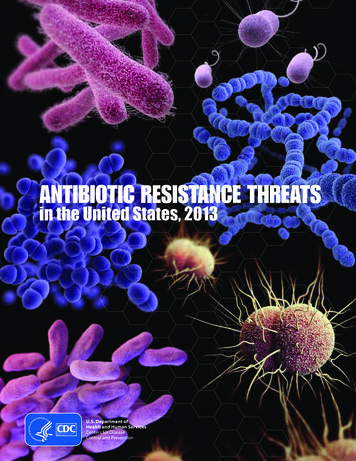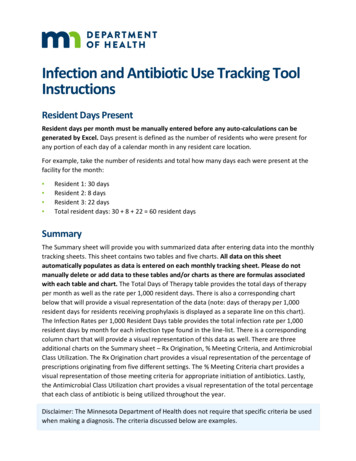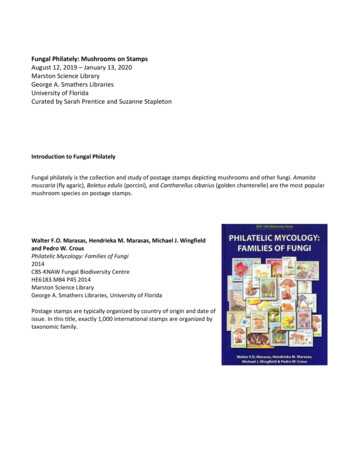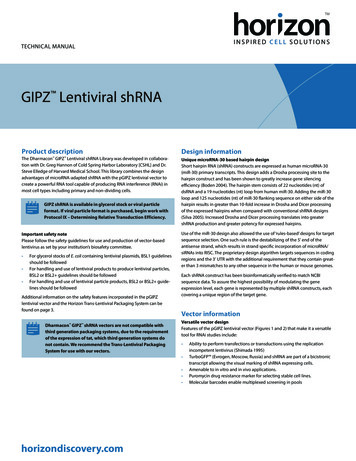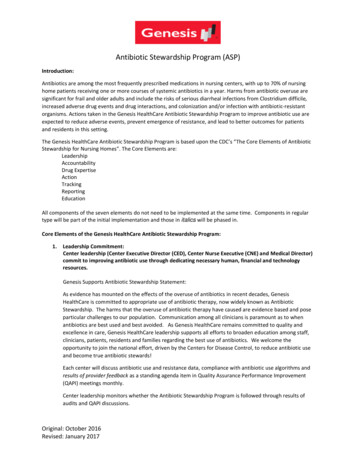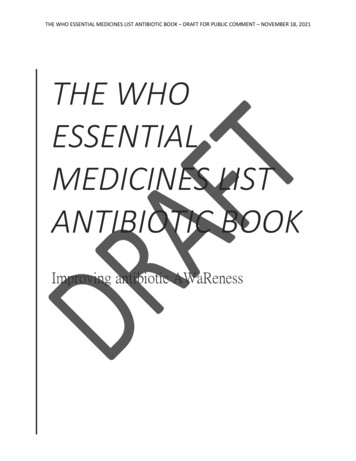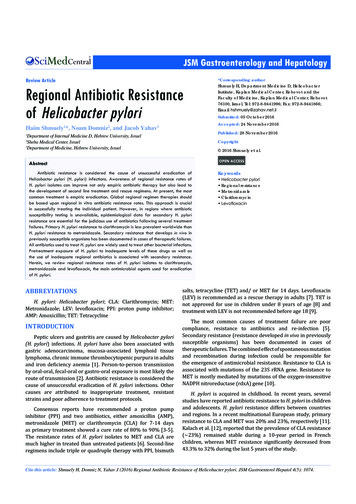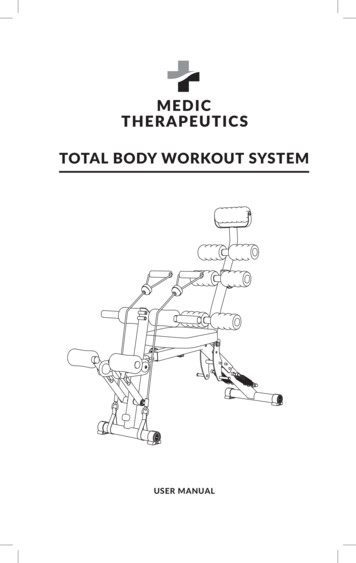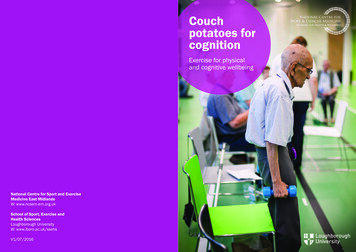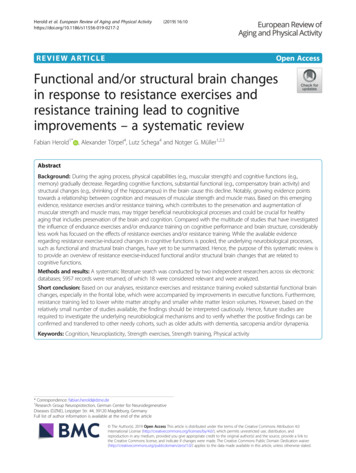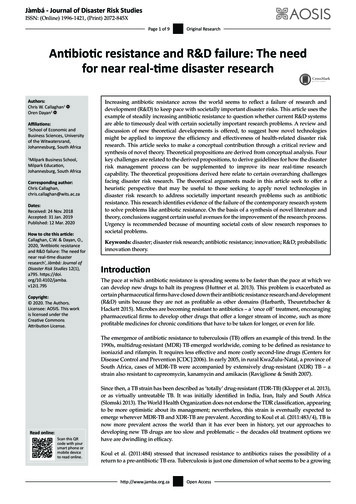
Transcription
Jàmbá - Journal of Disaster Risk StudiesISSN: (Online) 1996-1421, (Print) 2072-845XPage 1 of 9Original ResearchAntibiotic resistance and R&D failure: The needfor near real-time disaster researchAuthors:Chris W. Callaghan1Oren Dayan2Affiliations:1School of Economic andBusiness Sciences, Universityof the Witwatersrand,Johannesburg, South AfricaMilpark Business School,Milpark Education,Johannesburg, South Africa2Corresponding author:Chris : 24 Nov. 2018Accepted: 31 Jan. 2019Published: 12 Mar. 2020How to cite this article:Callaghan, C.W. & Dayan, O.,2020, ‘Antibiotic resistanceand R&D failure: The need fornear real-time disasterresearch’, Jàmbá: Journal ofDisaster Risk Studies 12(1),a795. https://doi.org/10.4102/jamba.v12i1.795Copyright: 2020. The Authors.Licensee: AOSIS. This workis licensed under theCreative CommonsAttribution License.Increasing antibiotic resistance across the world seems to reflect a failure of research anddevelopment (R&D) to keep pace with societally important disaster risks. This article uses theexample of steadily increasing antibiotic resistance to question whether current R&D systemsare able to timeously deal with certain societally important research problems. A review anddiscussion of new theoretical developments is offered, to suggest how novel technologiesmight be applied to improve the efficiency and effectiveness of health-related disaster riskresearch. This article seeks to make a conceptual contribution through a critical review andsynthesis of novel theory. Theoretical propositions are derived from conceptual analysis. Fourkey challenges are related to the derived propositions, to derive guidelines for how the disasterrisk management process can be supplemented to improve its near real-time researchcapability. The theoretical propositions derived here relate to certain overarching challengesfacing disaster risk research. The theoretical arguments made in this article seek to offer aheuristic perspective that may be useful to those seeking to apply novel technologies indisaster risk research to address societally important research problems such as antibioticresistance. This research identifies evidence of the failure of the contemporary research systemto solve problems like antibiotic resistance. On the basis of a synthesis of novel literature andtheory, conclusions suggest certain useful avenues for the improvement of the research process.Urgency is recommended because of mounting societal costs of slow research responses tosocietal problems.Keywords: disaster; disaster risk research; antibiotic resistance; innovation; R&D; probabilisticinnovation theory.IntroductionThe pace at which antibiotic resistance is spreading seems to be faster than the pace at which wecan develop new drugs to halt its progress (Huttner et al. 2013). This problem is exacerbated ascertain pharmaceutical firms have closed down their antibiotic resistance research and development(R&D) units because they are not as profitable as other domains (Harbarth, Theuretzbacher &Hackett 2015). Microbes are becoming resistant to antibiotics – a ‘once off’ treatment, encouragingpharmaceutical firms to develop other drugs that offer a longer stream of income, such as moreprofitable medicines for chronic conditions that have to be taken for longer, or even for life.The emergence of antibiotic resistance to tuberculosis (TB) offers an example of this trend. In the1990s, multidrug-resistant (MDR) TB emerged worldwide, coming to be defined as resistance toisoniazid and rifampin. It requires less effective and more costly second-line drugs (Centers forDisease Control and Prevention [CDC] 2006). In early 2005, in rural KwaZulu-Natal, a province ofSouth Africa, cases of MDR-TB were accompanied by extensively drug-resistant (XDR) TB – astrain also resistant to capreomycin, kanamycin and amikacin (Raviglione & Smith 2007).Read online:Scan this QRcode with yoursmart phone ormobile deviceto read online.Since then, a TB strain has been described as ‘totally’ drug-resistant (TDR-TB) (Klopper et al. 2013),or as virtually untreatable TB. It was initially identified in India, Iran, Italy and South Africa(Slomski 2013). The World Health Organization does not endorse the TDR classification, appearingto be more optimistic about its management; nevertheless, this strain is eventually expected toemerge wherever MDR-TB and XDR-TB are prevalent. According to Koul et al. (2011:483/4), TB isnow more prevalent across the world than it has ever been in history, yet our approaches todeveloping new TB drugs are too slow and problematic – the decades old treatment options wehave are dwindling in efficacy.Koul et al. (2011:484) stressed that increased resistance to antibiotics raises the possibility of areturn to a pre-antibiotic TB era. Tuberculosis is just one dimension of what seems to be a growinghttp://www.jamba.org.zaOpen Access
Page 2 of 9problem of antibiotic resistance. The increasing disasterpotential of antibiotic resistance is highlighted by Nathan(2004:899) in his question, posed in the journal Nature – the‘challenge is this: what can be done about the level ofantibiotic R&D, which has long been insufficient to meet theneeds of most populations, and now is plummeting?’ Giventhe disaster threat of antibiotic resistance, the objective of thisarticle was to provide a conceptual review of what seems tobe a growing knowledge problem in biomedicine, namely,the threat of a return to a pre-antibiotic era – a researchproblem that exists within a global R&D system. In doing so,we seek to offer a predictive model in the form of theoreticalpropositions for how novel theory and developments intechnology might ultimately address the problem of slowdisaster research response to potentially catastrophic threats.This article seeks to contribute to disaster risk theoryliterature in the following ways. Given the mountingevidence of a global slowdown in returns to research (Cowen2011; Gordon 2016), and theoretical models that explain whyit is occurring (Kortum 1997; Segerstrom 1997), we connectthis literature to evidence of growing threats such as TDR-TBas well as long-standing evidence of spreading antibioticresistance (Goossens et al. 2005; Kumarasamy et al. 2010;Neu 1992). In doing so, this synthesis is used to argue that afailure to prioritise the discovery of novel theories and newtechnologies and to apply these to the improvement of thediscovery process itself could have catastrophic consequences.This article therefore reviews different literatures in light ofalternative bodies of theory that demonstrate how a globalslowdown in innovation might be reversed through differentmechanisms. Examples of theory that predict thesemechanisms include theoretical predictions associated withthe interactive contribution of novel technologies of thefourth industrial revolution (Schwab 2017), or the secondmachine age (Brynjolfsson & McAfee 2014), which suggestshow technologies can leverage or amplify human collectiveintelligence (and therefore disaster research problemsolving). Having foregrounded certain of the ideas wesynthesise in this article, we now revisit literature relating tothe threat of growing microbial resistance to drugs.Growing resistance to all forms ofantibioticsHow does bacterial resistance to antimicrobial agents occur?Bacterial resistance to antimicrobial agents occurs throughdifferent mechanisms. One mechanism acts throughchromosomal changes and the way bacteria can exchangebetween themselves genetic material via plasmids andtransposons (Neu 1992). Bacteria can therefore exchangegenetic material amongst themselves, which makes themresistant to antibiotics.As bacteria can share antibiotic genes between them, it isdifficult to stop their spread. Mobile genes on plasmids canspread though bacterial populations, enabled by ‘unprecedentedair travel and migration’, which allows bacterial plasmids andclones to be transferred across continents (Kumarasamy et al.http://www.jamba.org.zaOriginal Research2010:597). This is particularly problematic, as one region mightuse antibiotics conservatively, but resistance can now spreadacross regions. As an example of this growing threat,Kumarasamy et al. (2010) identified isolates that show thespread of MDR Enterobacteriaceae between the UnitedKingdom, India and Pakistan.According to Huttner et al. (2013:1), microbes ‘have globalizedalong with their hosts, while at the same time antimicrobialconsumption by these hosts – both humans and animals –has exploded’, and the ‘gene pool for antimicrobial resistancehas never been so accessible, nor its selection pressure sostrong’. Harbarth et al. (2015) argued that a ‘discovery void’has developed over the past 20 years in the form of a failureto respond to this threat, as most pharmaceutical companieshave closed down their antibiotic resistance R&D units.If most pharmaceutical companies have closed down theirantibiotic R&D units, this discovery void might contribute tothe return to a pre-antibiotic era. Given the incentive structuresof the global pharmaceutical industry, it must be asked: isantibiotic resistance inevitable under the current global R&Dsystem? According to Huttner et al. (2013:1), humans are‘being outrun’, as antibiotic resistance is overtaking our R&Dcapabilities. According to Huttner et al. (2013):[H]umans are being outrun: there have been no successfuldiscoveries of new classes of antibiotics since 1987, whilenew, multiresistant pathogens such as carbapenem-resistantenterobacteriacae (CRE) are spreading with unprecedentedalacrity. (p. 1)In an age of multi-drug resistance, new approaches such asthe use of bacterial viruses (phages) to infect bacteria at thesite of infection are receiving increased attention (Lin,Koskella & Lin 2017). A review of medicinal chemistry toolsand challenges currently faced by antibiotic research isprovided by Singh, Young and Silver (2017). It is not clear,however, if such approaches will ultimately be successful.The consequences of antibiotic resistance forpoor populationsData suggest that ‘antimicrobial misuse, prophylactic use,diagnostic imprecision, and interpersonal spread are keyfactors in the selection and dissemination of resistant strains’,whereby all ‘these factors are promoted by poverty at theindividual patient, health system, and national levels’(Okeke 2009).Antibiotic consumption seems to have increased the most indeveloping countries. Over the period 2000–2010, globalconsumption of antibiotic drugs increased by 36%, ofwhich Brazil, Russia, India, China and South Africa(BRICS countries) were responsible for 76% of the increase(Van Broeckel et al. 2014).To prevent ‘a striking rise in resistance in low-income andmiddle-income countries with large populations and topreserve antibiotic efficacy worldwide’, coordinated effortsOpen Access
Page 3 of 9are needed by the international community to promote moreconservative use of antibiotics (Van Broeckel et al. 2014:1).However, as mentioned previously, if a microbe developsresistance in one region, it can quickly spread to all otherregions of the world; hence, supplementary strategies areneeded.Co-infections of human immunodeficiency virusor tuberculosis and human immunodeficiencyvirus or malariaAntibiotic resistance is accelerating because of co-infections,such as those between human immunodeficiency virus (HIV)and TB, which exacerbates the morbidity and mortality ofeach alone (Deidrich & Flynn 2011). Over a billion people areat risk from malaria - in 2016, at least 212 million cases werereported, with 445 000 fatalities, most of these being amongstAfrican children (Mandala et al. 2018). Malaria is alsodeveloping resistance to current drugs. Co-infection withHIV exacerbates the dangers of malaria (Mandala et al. 2018).Even more serious is the risk of co-infections of HIV, TB andmalaria, found to be associated with migrant workers andtravel to high-risk countriesIs antibiotic resistance a symptom of a largerproblem with the discovery system itself?Antibiotic resistance is particularly problematic becauseindustry’s ‘retreat from developing new antibiotics is leadingto a loss of expertise in both practical and theoretical aspectsof antibiotic biology’ and as ‘industry reassigns or retires itsmicrobiologists’, fewer will be trained in academia, as theknowledge base will take years to rebuild (Nathan 2004:899).However, if the problem is associated with the globalpharmaceutical R&D system itself, then it might be necessaryto supplement the system with other approaches. Academicresearch can sometimes fail to take up innovative opportunitiesto improve research productivity (Rubin & Callaghan 2019).We argue that a problem of unresponsiveness to importantsocietal research imperatives exists across the global R&Dsystem itself.As stated previously, this literature is not new (see Cowen2011; Gordon 2016), and there exists formal theoreticaleconomic models that explain why it is becoming harder tomake scientific breakthroughs (see Kortum 1997; Segerstrom1997). We suggest that if evidence exists of the lack progress todate against antibiotic resistance, then we might be headed fora ‘cliff’, whereby the resistance to learning of microbes exhaustsour last defences against them. This evidence points to animpending disaster. If disaster risk reduction is a systematicapproach to the identification, assessment and reduction of therisks of disaster, then this article seeks to identify threatsassociated with the failure of the research system to solve theproblem of antimicrobial resistance. By identifying appropriatetheory, and what it predicts about improving the effectivenessof antibiotic research, we seek to derive useful insights intohow to reduce the risk of research failure.http://www.jamba.org.zaOriginal ResearchMethodologyThis article applies a conceptual critical review methodology.In doing so, literature and theory are synthesised in order todevelop propositions. These propositions are then used todevelop a research agenda. Recommendations are thenderived from this process. The strength of this methodologicalapproach is that it provides a synthesis of novel theory andideas, and develops testable propositions. Further research isthen tasked with testing these propositions. Certain microfoundations of theory are now considered, which mightsuggest how to mitigate the threat of research failureassociated with antibiotic resistance.Theoretical micro-foundationsWhich theoretical frameworks are useful in reconceptualisingscientific research as a real-time process? What are thetheoretical mechanisms that predict how this could beperformed? Leveraging collective human intelligence isperhaps one approach to address the above questions(Callaghan 2018a).Micro-foundational theory is a body of the theory thatencompasses theoretical relationships that predict how toimprove specific aspects of the research process, so as toattain near real-time research productivity. These aspects arefed into the disaster response process, which requires realtime knowledge of how to address the problem of microbialresistance. Macro-foundational theory relates to theoreticalpredictions about the overarching context of researchproductivity, or relationships at the aggregate level. Here, welimit our discussions of the disaster response to the researchprocess, which we consider to be particularly important inlight of the failure of the research response to the problem ofantibiotic resistance to date.Building on Malone, Laubacher and Dellarocas’s (2009)ideas, Callaghan (2018a) described this body of theory as‘networked science theory’, drawing on Nielsen’s (2012)term, and Nielsen’s arguments that changes to the discoveryprocess (the scientific research process) itself herald a newage in human development. Indeed, Nielsen (2012) arguedthat those looking back from the future will identify twoperiods in human history, namely the pre-networked scienceand post-networked science eras. For practical examples ofhow the research process itself is being accelerated throughthe application of the principles of networked science, seeNielsen (2012).Nielsen’s (2012) examples offer us useful insights into thepractices of research that successfully harness humancollective intelligence. We argue here that these examplesalso offer useful insights into how to attain real-time disasterresearch response. The practice of networked science, whichwe envision to provide important guidelines for how toattain real-time research capabilities, or the potential for realtime disaster response, is shown as the top portion of thepyramid in Figure 1. The practice, however, is underpinnedOpen Access
Page 4 of 9Original ResearchReal- me disaster research responseThe permuta on challenge (Proposi on 1)The pre-permuta on mode of science will experience diminishingreturns to R&D investments.Prac ceThe knowledge aggrega on challenge (Proposi on 2)Investments in research that are focussed on improvingknowledge aggrega on will have substan ally higher payoffsthan those focussed merely on me and costs in the researchprocess.Micro-founda onal theoryBalancing societal ra os challenge (Proposi on 3)Only through a focus on balancing societal R&D ra os is it possibleto solve most contemporary societally important researchproblems.Macro-founda onal theoryFIGURE 1: Levels of theory supporting the practice of real-time disaster response.by micro-foundational and macro-foundational theoreticalframeworks.Micro-foundational theory relates to the question of how thefront line of the research can be pushed back, or how economiesof scale can be developed within the research process itself.According to Bernstein, Klein and Malone (2012:41), it is nowincreasingly possible to solve problems using networks ofhumans and computers, a phenomenon that has been termed‘collective intelligence, social computing or various otherterms’. Although computer applications and open-sourcesoftware packages have been used in drug design for manydecades, novel theory suggests that such approaches have thepotential to contribute to economies of scale in the researchprocess, if used more extensively, and if certain theoreticalprinciples are applied to this purpose. Our argument here isthat investments in developing knowledge in this area alsosuffer from the societal benefit ratio effect – the number ofpeople or resource costs affected by antibiotic resistance(the denominator) is much larger than the numbers of peopleor resources involved or invested in researching how toaddress the problem. An important contribution of ourargument is its effect as a heuristic to help to focus attention onthe problem of very small societal benefit ratios.Crowds of people can now ‘share, recombine, and refine eachother’s creative outputs’ in open idea ecologies, and theseapproaches have led to successes like youtube.com,Wikipedia.org and Linux (Bernstein et al. 2012:41). Such anapproach, although already prevalent in scientific research,might have the potential to radically reduce time and costs inthe R&D process, if used more extensively.Commercial sites like InnoCentive have demonstrated proofof concept, putting scientific problems online for the crowd tosolve (Malone et al. 2009). In this way, complex scientificproblems are solved more quickly and cheaply than ispossible with closed models of in-house R&D. The primaryconstraint of the InnoCentive model, however, is perhaps thesize of the rewards put up for the solving of a particularproblem (Callaghan 2017). Radically increasing the size of thereward might increase the incentives of solvers, andthe speed at which solutions can be found. Antibiotichttp://www.jamba.org.zaThe R&D virtualisa on challenge (Proposi on 4)The virtualisa on of the research or R&D process is a necessarycondi on to enable the research produc vity required to balancesocietal R&D ra os.R&D, research and development.FIGURE 2: Necessary conditions for solving contemporary societally importantresearch problems.resistance is perhaps a useful candidate for this approach.Micro-foundational theory therefore contributes directly toimproving the economies of scale that are attainable in theresearch process itself.Theoretical macro-foundationsThere are certain insights that have recently emerged from thefield of big data analytics. According to Kitchin (2014), theadvent of the ‘big data’ era has led to a ‘new epistemologicalparadigm’ differentiated from traditional deductive‘knowledge-driven science’. According to Callaghan (2018b),implications of this perspective are not only that interconnectivityand interdisciplinary research will increasingly be enabled byexponentially increased data availability but also that newmodes of theory development are now possible.Permutation-based scienceThe primary macro-level theoretical frameworks offered byRomer (1990) and Weitzman (1998) seem to suggest thatbreakthroughs in R&D might come through the recombinantprocesses of innovation and ensuring that ideas are shared inthe problem-solving process. Given the advent of the big dataera, however, it would seem that the ‘problem space’ of sciencehas radically expanded. If problem-solving can be representedas a topography, or a space, then Romer’s and Weitzman’stheoretical frameworks predict that the solutions to R&Dproblems like antibiotic resistance lie in the ability to theoriseand test permutations of presently existing knowledge.Thus, the first macro-theoretical principle of this article isderived here, that it is only the permutation-based eraof science that may hold the promise for achieving economiesof scale in the R&D process. The attainment of theseeconomies of scale might be a necessary condition for theOpen Access
Page 5 of 9solving of pernicious problems like antibiotic resistance.Therefore, we suggest:Proposition 1: The pre-permutation mode of science willexperience diminishing returns to R&D investments.We therefore argue here that the pre-permutation mode ofscience is simply not able to allocate the required researchresources in a way that matches the societal costs of certainproblems. This problem is arguably reflected in societal R&Dratios that suggest that vast positive externalities remainuntapped in the contemporary global R&D system.If it is only permutation-based science that can solve problemslike antibiotic resistance before its catastrophic consequences,we need to ask what dominant constraints exist to itsadoption? What overarching theoretical guidance can weglean from macro-level theory? A consideration of the seminalknowledge aggregation problem might offer us usefulinsights in this regard.The (seminal) knowledge aggregation problemProbabilistic innovation theory (PIT) (Callaghan 2017)predicts that radically improved cost and time savings canresult when problem spaces are ‘populated’ with largenumbers of solvers. This theory suggests that by balancingthe societal innovation ratio, it is possible to unfold a problemspace by populating it with large numbers of people inproportion to the importance (those affected by) of aparticular knowledge problem. A real-life example of this canbe found in the form of InnoCentive, a site that puts scientificproblems online to be solved for reward, using an open call.Probabilistic innovation theory seeks to reframe the focus oftheory development through the use of a heuristic to focusresearch problem-solving on knowledge aggregation, whichis taken to be the dominant constraint for progress in R&D.Drawing from the princsiples of PIT (Callaghan 2016a, 2016b,2017, 2018a), this can conceptually described as follows:ξ f(time * resources)ᵊThis heuristic suggests that the probability of solving anysolvable problem (ξ), although necessarily a function ofcomplex interactions of time and resources, is primarilysubject to the exponential influence of constraints associatedwith the knowledge aggregation problem ( ). This heuristicaccords with predictions of the importance of knowledgeaggregation (Hayek 1945; Von Hippel 1994) in knowledgecreation, particularly in terms of how to aggregate tacitknowledge (Nonaka 1994), which is at the level of theindividual (Polanyi 1973). An implication of this heuristic isthat a focus on improving knowledge aggregation mightensure that theory development is targeted on the mostimportant link in the aggregated problem-solving process. Onthe basis of these logics, the following proposition is derived:Proposition 2: Investments in research that are focussed onimproving knowledge aggregation will have substantiallyhigher payoffs than those focussed merely on time and costs inthe research process.http://www.jamba.org.zaOriginal ResearchIt must be noted that the quality of inputs into the Wikipediatype research process is a concern. An ethical frameworkpremised on the principles of post-normal science (Funtowicz& Ravetz 1994), however, suggests useful principles that canbe applied to maximise accountability and transparency inthe open research process.Have certain characteristics of the academic systemcontributed to a widening societal R&D ratio? From theperspective of computer science, Brookes (1996) issued thefollowing warning over two decades ago:[ W]e tend to forget our users and their real problems, climbinginto our ivory towers to dissect tractable abstractions of thoseproblems, abstractions that may have left behind the essence ofthe real problem. We talk to each other and write for each otherin ever more esoteric vocabularies, until our journals becomeinaccessible even to our society members, and publicationproperly commands a higher price from the author in page feesthan from the reader in subscription fees. (p. 62)Key to real-time knowledge aggregation is perhaps theleveraging of collective intelligence. Brookes (1996:64) arguedthat ‘intelligence amplifying systems can, at any given levelof available systems technology, beat AI [artificial intelligence]systems’, or in other words, ‘a machine and a mind can beat amind-imitating machine working by itself’. To obtaineconomies of scale in the research process, it is necessary toleverage human problem-solving capability, and this isperhaps only possible if the search for opportunities to applynovel technologies to the research process becomes animportant stream of research, in itself. In other words, ifsufficient researchers populate the numerator of its societalR&D ratio, and if the contributions of these researchers areleveraged using appropriate technologies, then this mightturn the tide in certain societally important areas of science,including the development of new antibiotics; hence, thefollowing proposition:Proposition 3: Only through a focus on balancing societal R&Dratios, is it possible to solve most contemporary societallyimportant research problems?The corollary of this proposition is that problems likeantibiotic resistance can only be consistently solved througha radical re-conceptualisation of our education systems andthe supply of researchers in the system. Knowledge of theincentives structures within science itself may also requirecareful scrutiny. If the attractiveness of laboratory-basedscience is not sufficient to attract the numbers of problemsolvers required for a balanced societal R&D ratio, then noveltheorising is required urgently.Virtualisation of the research orresearch and development processAs stated above, strengthening the numerator of the societalR&D ratio might occur by simply populating an unfoldedresearch problem space with large numbers of researchers.This can currently be performed using methodologies likecrowdsourced R&D. If technology can be used to leverage theOpen Access
Page 6 of 9contributions of these researchers included in the numerator,then their societal impact might be substantially increased,relative to the denominator, or the numbers of people whobear the consequences of a failure to solve a societallyimportant knowledge problem. This type of approach is notnew. According to Brookes (1996:64), more attention shouldbe paid to how humans can work synergistically withartificial intelligence, and computer graphics research may bekey to this.Theory development should therefore be targeted at thepotential to leverage, or amplify, collective intelligence(Malone et al. 2009; Nielsen 2012) in the knowledge creationprocess, but with a specific focus on knowledge aggregation,and targeted attempts to transcend the knowledgeaggregation threshold. Research should seek to identify andquantify the dimensions of the knowledge aggregationthreshold associated with different societally importantresearch problems (Callaghan 2017).We suggest here that appropriate processes within theresearch system should be mapped, and assessed as to theirdegree of resistance to virtualisation, with a goal ofvirtualising whichever processes and entire systems that areappropriate in the pursuit of a virtualised discovery system.A virtualised discovery system is a system of research thattaps into the near-zero marginal cost model of digitalprocesses. Although the arguments made here are broad, andtheir granularity is necessarily limited, being at a certainlevel of abstraction, we suggest that if viewed through theheuristic lens of knowledge aggregation and societal R&Dratio logics, then these insights may provide a useful focusfor further theory development. The following proposition isderived from these discussions:Proposition 4: The virtualisation of the research or R&D process isa necessary condition to enable the research productivityrequired to balance societal R&D ratios.A corollary of this proposition is that a radical reconceptualisation of the research process is necessary inorder to solve problems like antibiotic resistance. In itscurrent form, it seems as if the probability that it canadequately address threats such as antibiotic resistance isuncertain. These propositions are taken to be necessaryconditio
1School of Economic and Business Sciences, University of the Witwatersrand, Johannesburg, South Africa 2Milpark Business School, Milpark Education, Johannesburg, South Africa Corresponding author: Chris Callaghan, chris.callaghan@wits.ac.za Dates: Received: 24 Nov. 2018 Accepted: 31 Jan. 2019 Published: 12 Mar. 2020 How to cite this article:
